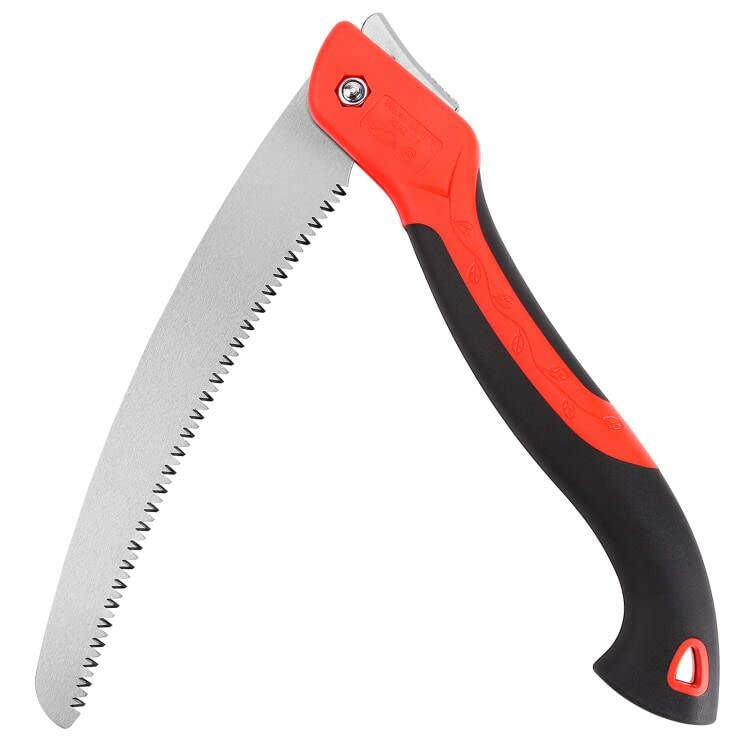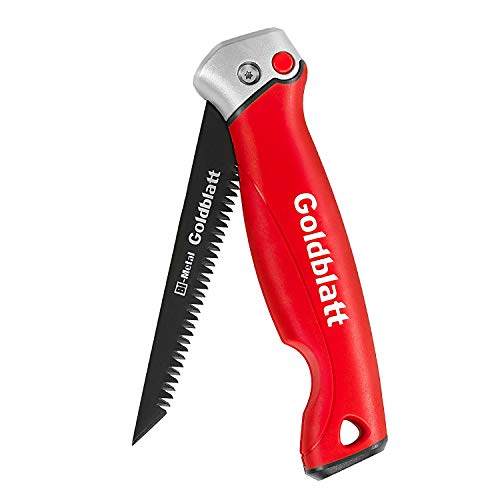When it comes to precision and reliability, nothing beats a well-crafted hand saw. But with so many options on the market, finding the right one can feel overwhelming. That’s why we’ve put together this detailed review of the best hand saws available today.
Need something for larger projects? You might also be interested in the best hole saw kit for drilling clean openings or the best gas pole saws for tree trimming if you’re working outdoors. For general woodworking, our list of the best saws across categories offers even more insights.
So, what’s in it for you? We’ll cover durability, ease of use, cutting efficiency, and price. Stick with us—because the right hand saw can transform your work from frustrating to effortless. Ready to cut through the noise? Let’s dive in.
Top pick
Best Foldable: Klein Tools 31737 Folding Jab Saw / Drywall Hand Saw
This drywall saw from Klein Tools features a foldable design for safe storage and portability. The carbon steel blade delivers reliable cutting strength, while the plastic handle with rubber grips ensures better comfort and control. Its lightweight construction makes it easy to maneuver, especially for overhead or tight-space work.
From a user perspective, the folding function and solid build are highly appreciated, though some may find the blade length restrictive for larger projects. Professionals value its portability and ease of use, while DIY users note it works best for quick, precise cuts.
Overall, this saw provides dependable performance and strong value for light to medium drywall tasks, making it a practical addition for both tradespeople and homeowners.
Best Precision: JORGENSEN 15” Hand Saw, Black Coated Coarse Handsaw
The Jorgensen hand saw comes with a 15-inch steel blade designed for smooth cuts on wood and plastic. Its aluminum handle provides a sturdy, comfortable grip for better control. With a cutting angle of 90 degrees, it is well suited for precise straight cuts.
From a user standpoint, the longer blade is appreciated for handling larger pieces, though the lower tooth count may make fine cutting less efficient. The saw’s solid construction and balanced feel receive positive feedback, but its weight can be a drawback for extended use.
Overall, this tool offers reliable cutting performance with durability and control, making it a good choice for general woodworking and plastic cutting tasks.
Best Versatile: 8-In-1 Multi Blades Hand Saw, Drywall Cutter. Hacksaw
The TOOLAN 8-in-1 hand saw features an interchangeable blade system with eight high-speed steel blades, allowing use on drywall, wood, and plastic. The keyed blade change and three-slot handle design make swapping and securing blades quick and simple. Its lightweight construction enhances maneuverability for detailed or overhead cuts.
From a customer perspective, the versatility and ease of blade replacement are highly valued, though the plastic handle may feel less durable under heavy use. The saw is praised for providing multiple cutting options in a single compact tool.
Overall, it delivers strong utility and convenience for light to medium tasks, making it ideal for DIYers and professionals seeking a flexible hand saw solution.
FAQs
What hand saw is best for cutting trees?
For cutting trees, a coarse-toothed hand saw designed for pruning is typically the best choice. These saws feature larger, sharper teeth that can slice through green wood quickly without clogging. A bow saw is also effective for larger branches, offering more power and speed. If portability matters, a folding pruning saw provides both convenience and cutting strength, making it a favorite among gardeners and landscapers.
Are Japanese handsaws better?
Japanese handsaws, often called pull saws, are highly regarded for their precision and clean cuts. Unlike Western saws that cut on the push stroke, Japanese models cut on the pull stroke, which reduces binding and allows for thinner, sharper blades. This design is excellent for fine woodworking where accuracy and smooth finishes are essential. However, they are not always the best choice for heavy-duty tasks like rough lumber cutting, where a traditional Western saw might perform better.
How to choose a good hand saw?
Choosing the right hand saw depends on your project needs. First, consider the type of material you’ll cut—softwood, hardwood, or green wood. Tooth count is also important: fewer teeth per inch (TPI) make faster, rougher cuts, while higher TPI saws produce smoother, precise finishes. Handle design should offer comfort and control, especially if you’ll be sawing for extended periods. Finally, look for quality steel blades that resist bending and stay sharp longer, ensuring reliability over time.
Which brand of saw is the best?
Several brands stand out for their consistent quality. Stanley and Irwin are trusted for durable, affordable options suitable for everyday DIY work. Silky and Bahco are renowned for their pruning saws, favored by professionals for tree and garden care. For woodworking, Japanese brands like Gyokucho and Suizan produce some of the finest pull saws, admired for their precision and craftsmanship. The “best” brand ultimately depends on your intended use and budget.
Conclusion
The right hand saw is more than just a cutting tool—it’s an investment in accuracy, efficiency, and comfort. From pruning trees to crafting furniture, the options highlighted here give you reliable choices tailored to different needs. Whether you prefer the precision of a Japanese pull saw or the rugged strength of a Western-style blade, the key is matching the tool to the task. With the insights from this guide, you’re now equipped to pick the best hand saw for your projects with confidence.





















